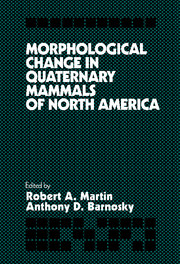Book contents
- Frontmatter
- Contents
- List of Contributors
- Acknowledgments
- 1 Quaternary mammals and evolutionary theory: introductory remarks and historical perspective
- 2 A method for recognizing morphological stasis
- 3 Mosaic evolution at the population level in Microtus pennsylvanicus
- 4 Variogram analysis of paleontological data
- 5 Morphological change in Quaternary mammals: a role for species interactions?
- 6 Rates of evolution in Plio-Pleistocene mammals: six case studies
- 7 Patterns of dental variation and evolution in prairie dogs, genus Cynomys
- 8 Quantitative and qualitative evolution in the giant armadillo Holmesina (Edentata: Pampatheriidae) in Florida
- 9 Evolution of mammoths and moose: the Holarctic perspective
- 10 Evolution of hypsodonty and enamel structure in Plio-Pleistocene rodents
- 11 Patterns of variation and speciation in Quaternary rodents
- 12 Decrease in body size of white-tailed deer (Odocoileus virginianus) during the late Holocene in South Carolina and Georgia
- 13 Short–term fluctuations in small mammals of the late Pleistocene from eastern Washington
- 14 Size change in North American Quaternary jaguars
- 15 Ontogenetic change of Ondatra zibethicus (Arvicolidae, Rodentia) cheek teeth analyzed by digital image processing
- 16 Morphological change in woodrat (Rodentia: Cricetidae) molars
- Index
14 - Size change in North American Quaternary jaguars
Published online by Cambridge University Press: 15 December 2009
- Frontmatter
- Contents
- List of Contributors
- Acknowledgments
- 1 Quaternary mammals and evolutionary theory: introductory remarks and historical perspective
- 2 A method for recognizing morphological stasis
- 3 Mosaic evolution at the population level in Microtus pennsylvanicus
- 4 Variogram analysis of paleontological data
- 5 Morphological change in Quaternary mammals: a role for species interactions?
- 6 Rates of evolution in Plio-Pleistocene mammals: six case studies
- 7 Patterns of dental variation and evolution in prairie dogs, genus Cynomys
- 8 Quantitative and qualitative evolution in the giant armadillo Holmesina (Edentata: Pampatheriidae) in Florida
- 9 Evolution of mammoths and moose: the Holarctic perspective
- 10 Evolution of hypsodonty and enamel structure in Plio-Pleistocene rodents
- 11 Patterns of variation and speciation in Quaternary rodents
- 12 Decrease in body size of white-tailed deer (Odocoileus virginianus) during the late Holocene in South Carolina and Georgia
- 13 Short–term fluctuations in small mammals of the late Pleistocene from eastern Washington
- 14 Size change in North American Quaternary jaguars
- 15 Ontogenetic change of Ondatra zibethicus (Arvicolidae, Rodentia) cheek teeth analyzed by digital image processing
- 16 Morphological change in woodrat (Rodentia: Cricetidae) molars
- Index
Summary
The jaguar (Panthera onca), largest of the New World felids, was formerly widespread in the Neotropical and Nearctic regions. In North America, pre–Wisconsinan jaguars ranged farther north than did those of the Wisconsinan. The present–day range of this species is far to the south of its Wisconsinan range (Figure 14.1). This illustrates a gradual restriction in the range of this species, though this general trend probably was influenced by a sequence of glacial–interglacial shifts in range (Kurtén and Anderson, 1980). The earliest jaguar may have been conspecific with the middle Pleistocene P. gombaszoegensis of Eurasia (Hemmer, 1971) that probably dispersed across the Bering land bridge to reach North America at that time (Kurtén, 1973). If that is true, the living species can be considered a relict population of a once more widely distributed Holarctic form (Kurtén and Anderson, 1980).
Concurrent with this restriction in range was a reduction in size. According to Kurtén (1973), size reduction proceeded gradually from the Blancan (Curtis Ranch, now known to be Irvingtonian) (Kurtén and Anderson, 1980; Schultz, Martin, and Schultz, 1985) to the present, although it may have accelerated during the Holocene (Kurtén and Anderson, 1980). Also, there was a gradual shortening of the limbs, especially the metapodials. Hence, the earliest North American jaguar lacked some of the living jaguar's specializations – its limbs were longer and their distal portions were less shortened (Kurtén, 1973).
- Type
- Chapter
- Information
- Morphological Change in Quaternary Mammals of North America , pp. 343 - 372Publisher: Cambridge University PressPrint publication year: 1993
- 10
- Cited by

